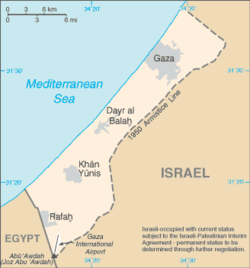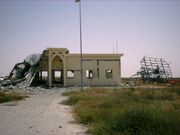Gaza Strip
2007 Schools Wikipedia Selection. Related subjects: Countries; Middle Eastern Countries
| قطاع غزة Gaza Strip |
|||||
|
|||||
| Anthem: Biladi | |||||
| Capital (and largest city) |
Gaza |
||||
| Official languages | Arabic | ||||
|---|---|---|---|---|---|
| Government | Palestinian National Authority | ||||
| Created | 1949 | ||||
| Area | |||||
| - Total | 360 km² ( 212th) sq mi |
||||
| - Water (%) | 0 | ||||
| Population | |||||
| - Density | 3,823/km² ( n/a) /sq mi |
||||
| GDP ( PPP) | estimate | ||||
| - Total | $768 million ( n/a) | ||||
| - Per capita | $600 ( n/a) | ||||
| Currency | Israeli new sheqel ( ILS) |
||||
| Time zone | ( UTC+2) | ||||
| - Summer ( DST) | ( UTC+3) | ||||
| Internet TLD | .ps | ||||
| Calling code | +970 | ||||
The Gaza Strip is a narrow coastal strip of land along the Mediterranean, in the Middle East. It takes its name from Gaza, its main city, and has about 1.4 million residents, all Palestinians, in an area of 360 km².
The Gaza Strip is not currently recognized internationally as a de jure part of any sovereign country. According to the international community the Gaza Strip is occupied by Israel; in particular, the United States government recognizes it as "Israeli-occupied with current status subject to the Israeli-Palestinian Interim Agreement - permanent status to be determined through further negotiation" . The Israeli government disputes this, especially after the withdrawal of Israel and the liquidation of its settlements in the strip in 2005.
Israel controls the Gaza strip's airspace and offshore maritime access. The Strip itself and its population is under the jurisdiction of the Palestinian Authority, which also operates the Strip's Rafah border crossing into Egypt under European Union supervision. The crossing has been closed due to Israeli demands since June 2006, after Israel recaptured parts of the Strip.
Background
Geographically, the Strip forms the westernmost portion of the Palestinian territories in Southwest Asia, having land borders with Egypt on the south-west and Israel on the north and east. On the west, it is bounded by the Mediterranean Sea.
The Strip's borders were originally defined by the armistice lines between Egypt and Israel after the 1948 Arab-Israeli War, which followed the dissolution of the British mandate of Palestine. It was occupied by Egypt (except for four months of Israeli occupation during the Suez Crisis) until it was captured by Israel in the 1967 Six-Day War. In 1993, after the Palestinian-Israeli agreements known as the Oslo Accords, much of the Strip came under limited Palestinian Authority control. In February 2005, the Israeli government voted to implement Prime Minister Ariel Sharon's plan for unilateral disengagement from the Gaza Strip beginning on August 15, 2005. The plan required the dismantling of all Israeli settlements there, transferring the lucrative hot house industry to Palestinian control to spur economic development, and the removal of all Israeli settlers and military bases from the Strip, a process that was completed on September 12, 2005 as the Israeli cabinet formally declared an end to military rule in the Gaza Strip after 38 years of control. The withdrawal was highly contested by the nationalist right in Israel, particularly the religious nationalist tendency, and some supporters of these tendencies now consider the Gaza Strip to be an occupied part of Israel. Following withdrawal, Israel retains offshore maritime control and control of airspace over the Strip. Israel withdrew from the " Philadelphi Route" that is adjacent to the Strip's border with Egypt after an agreement with the latter to secure its side of the border. The future political status of the Gaza Strip remains undecided, and is claimed as part of any prospective Palestinian state.
Demographics
Around 1.37 million Palestinians live in the Gaza Strip. The majority of the Palestinians are direct descendants of refugees who fled or were expelled from Israel during the 1948 Arab-Israeli War. By 1967, the population had grown about six-fold, and the Strip's population has continued to increase since that time. Poverty, unemployment, and poor living conditions are widespread, and their causes have been attributed to the extremely high birth rate, disruptions to the economy due to Israeli closure policies since the first intifada, and/or corruptness and inefficiency of the Palestinian Authority. From the 1970s onwards, 21 Israeli settlements were constructed in the Gaza Strip, but these were removed in August 2005. See Gaza Strip Israeli Settlements. On July 14, 2006, hundreds or thousands of Palestinians flooded into the Gaza Strip from Egypt, after Palestinian militants forced openings in the border wall. The Palestinian population is growing by around 4% a year. Over 99% residents of the strip are Palestinian Muslim, with a small Palestinian Christian (0.7%) minority.
Demographic numbers for the Gaza Strip are acquired from the Palestine Ministry of Health (2005 estimates) :
- Birth rate: 30.8 births/1,000 population (2005 est.)
- Death rate: 3.2 deaths/1,000 population :
- net migration: 1.54 migrant(s)/1,000 population
- infant mortality: 21.3 deaths/1,000 live births
- fertility: 4.7 children born/woman
- Population growth rate: 2.8% :
Geography
The Gaza Strip which is located in the Middle East (at ). It has a 51km border with Israel, and an 11km border with Egypt, near the city of Rafah. Khan Yunis is located 7km northeast of Rafah, and several towns are located along the coast between it and Gaza City. Beit Lahia and Beit Hanoun are located to the north and northeast of Gaza City, respectively.
The Gush Katif bloc of Israeli localities used to exist on the sand dunes adjacent to Rafah and Khan Yunis, along the southwestern edge of the 40 km Mediterranean coastline. A few months after the disengagement in December 2005, a controversial buffer zone was created on the northern border with Israel. Part of it reaches 2.5 km into the Palestinian Authority controlled territory, on roughly the area of the former northern Israeli localities, an area now used to launch Qassam rockets into Israel.
The Gaza Strip has a temperate climate, with mild winters, and dry, hot summers subject to drought. The terrain is flat or rolling, with dunes near the coast. The highest point is Abu 'Awdah ( Joz Abu 'Auda), at 105 metres above sea level. Natural resources include arable land (about a third of the strip is irrigated), and recently discovered natural gas. Environmental issues include desertification; salination of fresh water; sewage treatment; water-borne disease; soil degradation; and depletion and contamination of underground water resources. It is considered to be one of the fifteen territories that comprise the so-called " Cradle of Humanity."
It currently holds the oldest known remains of a manmade bonfire and some of the world's oldest dated human skeletons.
Economy
Economic output in the Gaza Strip declined by about one-third between 1992 and 1996. This downturn has been variously attributed to corruption and mismanagement by Yassir Arafat and to Israeli closure policies—the imposition of generalized border closures which disrupted previously established labor and commodity market relationships between Israel and the Strip. The most serious negative social effect of this downturn was the emergence of high unemployment.
Israel's use of comprehensive closures decreased during the next few years and, in 1998, Israel implemented new policies to reduce the impact of closures and other security procedures on the movement of Palestinian goods and labor into Israel. These changes fueled an almost three-year-long economic recovery in the Gaza Strip. Recovery ended with the outbreak of the al-Aqsa Intifada in the last quarter of 2000. The al-Aqsa Intifada triggered tight IDF closures of the border with Israel as well as frequent curbs on traffic in Palestinian self-rule areas, severely disrupting trade and labor movements. In 2001, and even more severely in early 2002, internal turmoil and Israeli military measures in Palestinian Authority areas resulted in the destruction of capital plant and administrative structure, widespread business closures, and a sharp drop in GDP. Another major factor has been the decline of income earned due to reduction in the number of Gazans permitted entry to work in Israel. After the Israeli withdrawal from Gaza, Palestine again resumed the flow of a limited number of workers into Israel but has stated its intention to reduce or end such permits due to the victory of Hamas in the 2006 parliamentary elections.
During the time of Israeli settler presence in the Gaza Strip, settlers built greenhouses and experimented with new forms of agriculture. These greenhouses also provided employment for many hundred Gazan Palestinians. When Israel withdrew from the Gaza Strip in the Summer of 2005, these greenhouses were bought by the World Bank and given to the Palestinian people to jump-start their economy. Most of these greenhouses are now utilized by Palestinian farmers, although there have been incidents of looting and vandalism in a few locations.
According to the CIA World Factbook, GDP in 2001 declined 35% to a per capita income of $625 a year, and 60% of the population is now below the poverty line. Gaza Strip industries are generally small family businesses that produce textiles, soap, olive-wood carvings, and mother-of-pearl souvenirs; the Israelis have established some small-scale modern industries in an industrial centre. Electricity is supplied by Israel. The main agricultural products are olives, citrus, vegetables, Halal beef, and dairy products. Primary exports are citrus and cut flowers, while primary imports are food, consumer goods, and construction materials. The main trade partners of the Gaza Strip are Israel, Egypt, and the West Bank.
Health
A study carried out by Johns Hopkins University (USA) and Al-Quds University (in Jerusalem) for CARE International in late 2002 revealed very high levels of dietary deficiency among the Palestinian population. The study found that 17.5% of children aged 6–59 months suffered from chronic malnutrition. 53% of women of reproductive age and 44% of children were found to be anaemia. In the aftermath of the Israeli withdrawal of August and September 2005, the healthcare system in Gaza continues to face severe challenges .
Transport and communication
The Gaza strip has a small, poorly developed road network. It also had a single standard gauge railway line running the entire length of the strip from north to south along its centre; however, it is abandoned and in disrepair, and little trackage remains. The line once connected to the Egyptian railway system to the south as well as the Israeli system to the north.
The strip's one port was never completed after the outbreak of the Al-Aqsa Intifada. Its airport, the Gaza International Airport, opened on 24 November 1998 as part of agreements stipulated in the Oslo II Accord and the 23 October 1998 Wye River Memorandum. The airport was closed in October 2000 by Israeli orders, and its runway was destroyed by the Israel Defense Forces in December 2001. It has since been renamed Yasser Arafat International Airport.
The Gaza strip has rudimentary landline telephone service provided by an open-wire system as well as extensive mobile telephone services provided by PalTel (Jawwal) or Israeli providers such as Cellcom. Gaza is serviced by four internet service providers that now compete for ADSL and dial-up customers. Most Gaza households have a radio and a TV (70%+), and roughly 20% have a personal computer. People living in Gaza enjoy access to satellite television (Al Jazeera, Lebanese and Egyptian entertainment programs, etc.), local private channels, and broadcast TV from the Palestinian Broadcasting Corporation, the Israel Broadcasting Authority and the Second Israeli Broadcasting Authority.



